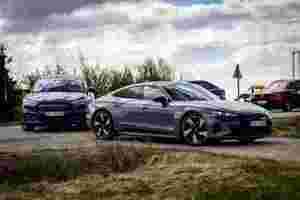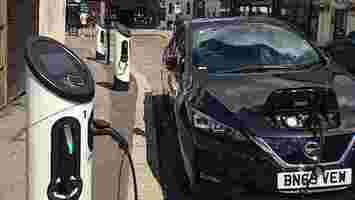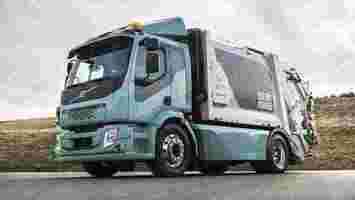Tesla still leads in Norway’s real-world range test, but Ford is getting very, VERY close
If you’ve ever shopped for an EV you will have almost certainly compared how far your vehicles of choice can drive on a single charge. Most manufacturers quote a WLTP range , which is calculated from a lab test and is intended to give an idea of how far the car can go on a single charge.

In reality, these WLTP figures can be quite far off the mark. If you’re serious about EV motoring, it pays to research what real-world range figures drivers report. Thankfully, those EV loving Norwegians have put a bunch of EVs through their paces on the open-roads, giving us an idea of how they hold up against their manufacturer quoted WLTP ranges.
Earlier today, Norway‘s automobile association (NAF) released the results of its latest summer range test . It tested 19 new vehicles including the Ford Mustang Mach-e, the Honda e, the BMW iX3, and the Audi e-tron GT.
Tesla still the top dog
Lucky for you, I’ve done the heavy lifting and put the results in a BEAUTIFUL chart (that you can play with), so you can easily see how the EVs rank against each other. You. Are. Welcome.
In previous years, Tesla had an unassailable lead over other manufacturers. However, Ford’s Mustang Mach-e Long Range is taking the fight to the American car maker, and is doing a great job of it.
The Mach-e pulled up just 37 km short of the 2021 long range Tesla Model 3. Both these cars (along with the Model 3 from 2020) drove more than 600 km (370 miles) on a single full charge, making them part of an exclusive group of long distance electric drives.
A standout vehicle was the BMW iX3. It’s not BMW’s first EV, but it’s the first one that might actually entertain the masses, what with being an SUV and all. If its function and looks weren’t enough to convince drivers, perhaps its range will.
It has a WLTP quoted range of just 450 km, but in NAF’s test it drove 556 km before running out of charge. That’s a whopping 20% more range than quoted on the sales sheet. Perhaps BMW needs to put it through the WLTP test again.


The Audi e-Tron GT also surpassed its WLTP figure by nearly 15%, driving 528 km — that’s 60 km more than lab tests suggest.
The EV test
NAF admits this isn’t the most scientific test, but rather stands as an indication of how cars fare against WLTP quoted range figures. Now, WLTP tests are meant to be scientific, yet, as NAF’s test proves, there is no consistency between what an EV does in a lab and what it can do out on the road.
However, NAF does have some protocols it follows. It charges all cars to 100% the night before driving them. No cars are preheated, they start from cold, and all run in eco mode and use active braking regeneration. Ambient temperatures on the day were perfect, being around 20-25 degrees Celsius.
The test is run by ordinary drivers in normal traffic on a mix of city, country, and motorway roads. The route begins in Oslo and heads towards Gjøvik. The entire test fleet drives over Lygnasæter, a climb of 620 meters before heading north to Dombås.
This isn’t the first time NAF has tested EVs to see if they match manufacturer WLTP claims.
In last year’s test , NAF found that 29 EVs surpassed their WLTP range figures. Also, as with this year, Tesla topped the table for total real-world range with its Model 3 and Model S taking the top two spots.
Do EVs excite your electrons? Do ebikes get your wheels spinning? Do self-driving cars get you all charged up?
Then you need the weekly SHIFT newsletter in your life. Click here to sign up .
UK to spend $27M on EV chargers… but is it enough?
This article was originally published by Christopher Carey on Cities Today , the leading news platform on urban mobility and innovation, reaching an international audience of city leaders. For the latest updates follow Cities Today on Twitter , Facebook , LinkedIn , Instagram , and YouTube , or sign up for Cities Today News.

The UK government has pledged £20 million (US$27.4 million) to help local authorities install 4,000 on-street electric chargers over the next two years.
The funding, provided through its On-Street Residential Chargepoint Scheme, will double the amount of government-supported electric chargers to nearly 8,000.
Since the inception of the scheme in 2017, more than 140 local authority projects providing 4,000 charge points have been implemented.
UK Transport Secretary Grant Shapps said: “Drivers across the country should benefit from the electric vehicle revolution we’re seeing right now.
“With a world-leading charging network, we’re making it easier for more people to switch to electric vehicles, creating healthier neighborhoods and cleaning up our air as we build back greener.”
Petrol and diesel ban
The announcement comes almost three months after the government pledged to ban sales of new petrol and diesel cars from 2030, but doubts linger over whether the pace of charging rollout will meet expected demand.
Electric and plug-in hybrid vehicles accounted for more than 10% of all new car registrations in 2020, more than a threefold increase from 2019.
In its annual Report on Motoring released last month , the RAC found that 9% of 3,000 respondents said they intended to make a switch to electric the next time they change their vehicle – up from 6% in 2019 and 3% a year earlier.
Cost remains a significant barrier, however, with almost eight in ten UK motorists (78%) thinking that electric cars are still too expensive when compared to conventional vehicles of a similar size.
Five times more chargers needed
A new report by UK think tank Policy Exchange has found that 400,000 public chargers will be needed by 2030, and installations will need to accelerate five-fold annually over the next decade.
It also warned that without intervention, rural areas and small towns were at risk of becoming ‘charging blackspots.’
The report made several recommendations for the government to meet the demand, including contracting private firms to install chargers in areas where they are sparse and funding dedicated teams at local councils.
It also said that the maximum price at government-supported chargers should be regulated to avoid providers exploiting local monopolies.
Report author and Policy Exchange Senior Research Fellow Ed Birkett said: “Companies are rolling out charge-points at a record rate, but there’s a risk that some areas of the country won’t get enough charge-points and will be left behind.
“We’re concerned about patchy deployment of charge-points, which runs against the government’s plans for leveling up and a strong and connected Union.”
SHIFT is brought to you by Polestar. It’s time to accelerate the shift to sustainable mobility. That is why Polestar combines electric driving with cutting-edge design and thrilling performance. Find out how .
Why Australia’s trucks might go electric sooner than cars
Australia’s trucking industry is making moves to go electric. The latest development — a system for using swappable batteries instead of time-consuming recharge stations for long-haul trucks between Sydney and Brisbane — shows how this transition is gathering momentum.

There will be clear socio-economic, environmental and health-related benefits from the switch to electric trucks — for the broader community as well as for the trucking industry and truckies themselves. As electric vehicle researchers, we think swappable batteries could work well for trucking, but are perhaps less suitable for everyday electric cars.
Electric trucking
There are many benefits from electrifying truck transport. Companies such as Woolworths and Ikea have already started to transition to electric delivery vans for the environmental benefits (and a possible boost for their brands).
Many leading truck manufacturers such as Scania , Mercedes-Benz and Volvo are proceeding apace with trials and plans to make their trucks electric.
Trucks make up 20% of the vehicles in Australia, and Australia’s transport emissions are still growing .
Australia’s motor vehicles consume more than 33 billion litres of fuel each year. The transport sector was responsible for about 100 million tonnes of carbon dioxide emissions in 2019.
Australia spent some A$31 billion in 2019 to import oil , with half used for road transport . This not only affects Australia’s balance of trade, but poses a risk to our freight industry (including supermarket deliveries) if geopolitical instability affects fuel imports (which mainly come from just a few countries ).
The trucking company Linfox appears to have understood the advantages that transition to electric trucks can bring to its business, and is one of the early adopters trialling them here in Australia.
Not just trucking companies
Many big companies are making commitments to cut their carbon emissions, such as Fortescue Metals’ target of net zero operational emissions by 2040. Its mining fleet operations account for half of its operational emissions.
Procurement of electric trucks by government and mining fleets could not only help reduce transport emissions but signal to the community that the transition away from more polluting vehicles can be done.
Read more: Net-zero, carbon-neutral, carbon-negative … confused by all the carbon jargon? Then read this
Modernizing the fleet is an imperative that we need to prioritize. The business sector can play a key role in the success of the latest Australia Government Technology Investment roadmap .
Innovative solutions such as the truck battery swap system mean that not only big companies but also sole operators can make the change, by converting existing trucks and leasing batteries.
A typical articulated truck uses 53.1 litres of diesel per 100 kilometres. A trip from Brisbane to Sydney could cost more than A$600 in fuel (which you, the consumer, help pay for when you purchase transported goods). Going electric would not only at least halve that cost but reduce maintenance costs and reduce emissions , even if batteries are recharged from the grid.
Read more: Clean, green machines: the truth about electric vehicle emissions
Swap and go?
Swapping out depleted batteries, rather than stopping to recharge, is a great solution for trucks: they make regular trips along major routes with regulated rest stops for drivers, which means you only need battery-swapping stations at key points along the routes.
However, battery swapping for ordinary passenger vehicles may be a different story. It has been tried before, but didn’t take off.
A US-based company called Better Place, founded in 2007, got as far as setting up trial stations (with one even planned for Canberra). But the company collapsed in 2013.
One problem was that car manufacturers would have had to agree to use a common battery platform to enable swapping, and only Renault came on board. Another was that the cost of installing enough battery swap stations to satisfy the wider community was enormous.
Trucks travelling on major transport routes won’t face this problem, so battery-swapping has a better chance of success.
How to go electric
Our ongoing research on policies to foster electric vehicle adoption has found that electric passenger cars are mostly recharged at home. This means we need solutions to help those without off-street parking get access to convenient local rechargers. This will help Australia reduce its balance of trade problems, reduce our health costs, and help the environment.
We just have to hope our government comes on board with suitable regulatory action to help us all go electric. One step might be to follow the US government’s recent announcement that it will electrify its entire fleet of vehicles . This will help car manufacturers, help bring down carbon emissions, help reduce the nation’s health budget and also help everyday people reduce their transport costs, which would be fairer and more sustainable.
This article by Gail Broadbent , PhD candidate Faculty of Science UNSW, UNSW and Graciela Metternicht , Professor of Environmental Geography, School of Biological Earth and Environmental Sciences, UNSWSydney, UNSW , is republished from The Conversation under a Creative Commons license. Read the original article .